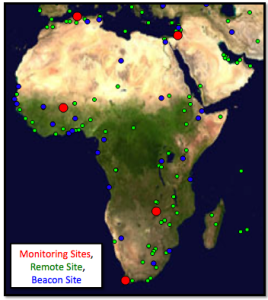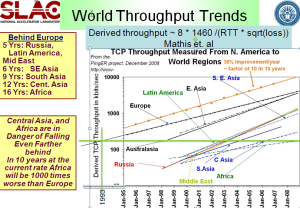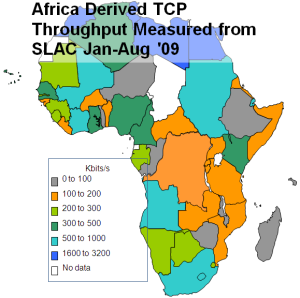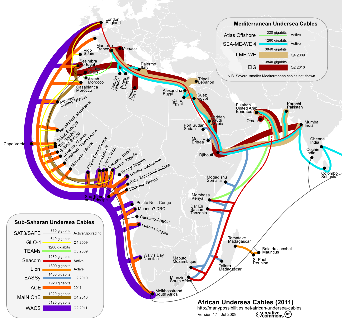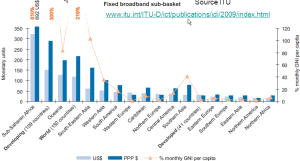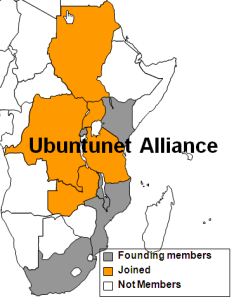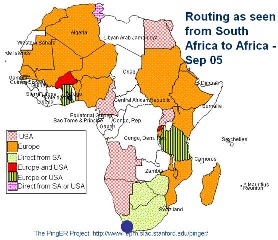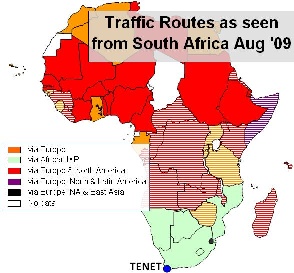...
PingER monitors over 165 sites in 50 countries, that contain about 99% of Africa's population. The African countries that are not currently monitored are Chad, Comoros, Equatorial Guinea, Sao Tome & Principe and Western Sahara. The results from PingER are used heavily in this study. Below is seen a map of the PingER sites in Africa. The red dots indicate PinGER monitoring sites, the blue are beacon sites that are monitored by most of the over 40 PingER monitoring sites around the world, and the green are other sites monitored by at least one monitoring site.
Current State
The throughputs measured to Africa from N. America for the last decade are shown below in the left hand figure. It is seen that not only do African sites lag the rest of the world in throughput, being roughly in the state that European sites were over a decade and a half ago, but also they are falling further behind with time. Further, bear in mind that for Africa, Mediterranean countries and South Africa have the better perfomance and E. Africa is the worst off (see the the middle left map). Thus the arrival of a terrestrial submarine fibre cable link to the rest of the world for E. Africa is a very significant development.
The minimum RTTs measured from SLAC to African countries in August 2009 are seen in the map on the right
<ac:structured-macro ac:name="unmigrated-wiki-markup" ac:schema-version="1" ac:macro-id="7212cc2f-c780-4611-932c-e2e1cc7e69d8"><ac:plain-text-body><![CDATA[ | Throughput from SLAC to Regions of the World | Derived Throughput from SLAC to Africa Jan-Aug '09 [[xlsx | ^africa-thru-aug09.xlsx]] | MinRTT from SLAC - Aug. 2009 [[xls | ^map-africa-minrtt-aug2009.xls]] | ]]></ac:plain-text-body></ac:structured-macro> |
|---|---|---|---|---|---|---|
|
|
|
The striking number of countries in Eastern and Central Africa with minimum RTTs of >400ms is indicative that they were using GEO-Stationary (GEOS)satellite links.
At the moment the SAT-3/WASC/SAFE fibre has been in place for some time and connects up several countries on the W. Coast of Africa. The Seacom line is not the only fiber-optic cable project on Africa's East coast — others include the Eastern Africa Submarine Cable Systems (EASSY), The East African Marine System (TEAMS) and Lion — but it will be the longest and have highest capacity (1.28 terabytes per second). The EASSY and TEAMS are designed to build out African telecommunications networking, but Seacom is the only line that directly will connect east coast urban areas in Kenya, Madagascar, Mozambique, South Africa and Tanzania to France and India. TEAMS landed in Mombasa early June 2009 and is currently undergoing testing while EASSY and Lion are expected to be operational by mid-2010. Maps of the various fibres is shown below and more details are available here.
Submarine Fibre Cables ro E. Africa
At the moment the SAT-3/WASC/SAFEfibre has been in place for some time and connects up several countries on the W. Coast of Africa. The Seacom line is not the only fiber-optic cable project on Africa's East coast — others include the Eastern Africa Submarine Cable Systems (EASSY), The East African Marine System (TEAMS)and Lion — but it will be the longest and have highest capacity (1.28 terabytes per second). The EASSY and TEAMS are designed to build out African telecommunications networking, but Seacom is the only line that directly will connect east coast urban areas in Kenya, Madagascar, Mozambique, South Africa and Tanzania to France and India. TEAMS landed in Mombasa early June 2009 and is currently undergoing testing while EASSY and Lion are expected to be operational by mid-2010. Maps of the various fibres is shown below and more details are available here.
For the interior backbones (or backhauls) associated with these landing points, see here.
Current State of the Afreican Internet
The throughputs measured to Africa from N. America for the last decade are shown below in the left hand figure. It is seen that not only do African sites lag the rest of the world in throughput, being roughly in the state that European sites were over a decade and a half ago, but also they are falling further behind with time. Further, bear in mind that for Africa, Mediterranean countries and South Africa have the better perfomance and E. Africa is the worst off (see the the left map below). Thus the arrival of a terrestrial submarine fibre cable link to the rest of the world for E. Africa is a very significant development.
The minimum RTTs measured from SLAC to African countries in August 2009 are seen in the map on the right
<ac:structured-macro ac:name="unmigrated-wiki-markup" ac:schema-version="1" ac:macro-id="d2939551-0c33-433e-b828-c1d910902230"><ac:plain-text-body><![CDATA[ | Throughput from SLAC to Regions of the World | Derived Throughput from SLAC to Africa Jan-Aug '09 [[xlsx | ^africa-thru-aug09.xlsx]] | MinRTT from SLAC - Aug. 2009 [[xls | ^map-africa-minrtt-aug2009.xls]] | ]]></ac:plain-text-body></ac:structured-macro> |
|---|---|---|---|---|---|---|
|
|
|
The striking number of countries in Eastern and Central Africa with minimum RTTs of >400ms is indicative that they were using GEO-Stationary (GEOS)satellite linksFor the interior backbones (or backhauls) associated with these landing points, see here.
East Africa contains 300M people, yet less than 3% are Internet users (see Internet usage for Africa). Bandwidth in Africa is very expensive. See for example the left hand figure below when where it is seen that bandwidth costs for broadband in Sub-Saharan Africa are 30-40 times that in the US. Taken together with the earnings differences, what takes say 15% of a US Gross National Income (GNI) per capita will take over 800% of a Sub-Saharan GNI per capita.
Costs of Broadband Internet Access in Countries of the world. |
|---|
|
Emergence of National Research and Education Networks (NRENs) & Routing
In the past the area has had poor Internet connectivity with heavy use of expensive (in terms of $/Mbps) geostationary satellite connections to the outside world. (see above) In addition most of the traffic between countries made use of expensive international links via Europe and the U.S. rather than more direct connections. There are active movements to create National Research and Education Networks (NRENs) in the area, see for example "Sub-Saharan Africa: An update" by Boubaker Barry. This, together with direct connections between countries will enable more direct peering. These NRENs in turn are peering with the GEANT network in Europe through the Ubuntunet Alliance. The map below shows the state of African NRENs in 2008 and to the right of it the Founding Ubuntunet Alliance members and those who have joined since the founding.
...
.
NRENs in Africa | Ubuntunet Alliance | |
|---|---|---|
| |
It can be seen that NRENs are being created.
...
<ac:structured-macro ac:name="unmigrated-wiki-markup" ac:schema-version="1" ac:macro-id="33040770a04df8c8-61450caf-426a43d9-ab33ab2d-c70e80ba5cae504e68c9658f"><ac:plain-text-body><![CDATA[ | Routing from South Africa to African Countries (Sep '05) | Routing from South Africa to African Countries (Aug '09) [[xls | ^routing-africa-aug2009.xls]] | Routing from Burkina Faso to African Countries (Aug '09) [[xls | ^routing-africa-aug2009.xls]] | ]]></ac:plain-text-body></ac:structured-macro> |
|---|---|---|---|---|---|---|
| |
|
...
Steve Song pointed out that a good PingER point would be the Durban University of Technology. They are the only university in South Africa to be currently connected to Seacom. All the rest are waiting for the development of the national SANREN backbone, later this year. I added www.dut.ac.za to the list of hosts monitored by PingER on 8/6/09. We will look to see whether we can see differences between it and other hosts monitored in South Africa.
Later Results Illustrating Impact of Changes
To assist in the selection of hosts in this region from the pingtable results, we created an affinity group that contains all hosts in Kenya, Mozambique and Tanzania. This makes it much simpler to look at the minimum RTT for just such hosts for the last few days
...
